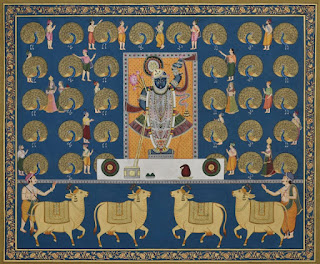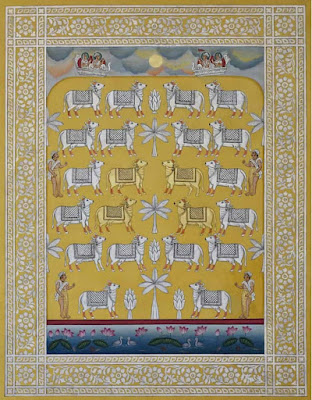The Rich History and Symbolism of Shrinathji Paintings
Exploring the Timeless Art and Deep Symbolism of Shrinathji Paintings
Introduction
Shrinathji paintings, a profound expression of devotion and artistic brilliance, have captivated the hearts of many for centuries. These paintings, depicting the divine form of Shrinathji—an incarnation of Lord Krishna—are not merely artworks but spiritual representations that connect devotees to the divine. Originating from the sacred town of Nathdwara in Rajasthan, Shrinathji paintings have a rich history intertwined with religious significance and cultural heritage.
The intricate details, vibrant colors, and symbolic elements
of Shrinathji paintings make them a unique art form that has evolved over the
centuries. These paintings are a testament to the artistic ingenuity and
deep-seated spiritual traditions of India. Whether displayed in temples or
homes, Shrinathji paintings bring a sense of divinity and peace, reflecting the
profound love and reverence for Lord Krishna.
In this article, we will delve into the rich history and symbolism of Shrinathji paintings, exploring their origins, artistic techniques, and cultural significance. We will also highlight modern interpretations and the best places to purchase these exquisite artworks online. Join us on this journey to uncover the timeless beauty and spiritual depth of Shrinathji paintings.The Origins of Shrinathji Painting
Historical Background
Shrinathji paintings trace their roots to the 17th century
in the picturesque town of Nathdwara, Rajasthan. This town became a spiritual
and cultural hub when the idol of Shrinathji, a manifestation of Lord Krishna,
was installed there. The idol, which depicts Krishna lifting Mount Govardhan
with his left hand, inspired a unique form of devotional art that soon
flourished in the region. These paintings were initially created to adorn the
temple and illustrate the various leelas (divine activities) of Shrinathji,
providing devotees with a visual medium to engage with the deity's divine
presence.
The early Shrinathji paintings were characterized by their simplicity, focusing primarily on religious elements and the direct representation of the deity. However, as time progressed, these paintings began to incorporate more elaborate details and vibrant colors, reflecting the evolving artistic trends and socio-cultural influences. The artisans of Nathdwara became renowned for their exceptional skill and devotion, creating masterpieces that captured the essence of Shrinathji's divinity and charm.
Evolution Over Centuries
The artists, often belonging to the same families for
generations, passed down their skills and knowledge, ensuring the continuity of
this sacred art form. Over the centuries, Shrinathji paintings have not only
preserved their religious significance but also adapted to contemporary tastes
and preferences, making them relevant to modern devotees and art enthusiasts
alike.
Symbolism and Iconography
Depiction of Shrinathji
One of the most striking features of Shrinathji paintings is the distinctive portrayal of the deity. Shrinathji is typically depicted with a left hand raised, symbolizing the divine act of lifting Mount Govardhan to protect the villagers of Vrindavan from torrential rains. This iconic pose is central to Shrinathji paintings, emphasizing the themes of protection and divine intervention.
The deity is often shown adorned in elaborate costumes and jewelry, reflecting the grandeur and opulence associated with Krishna. The vibrant attire and intricate adornments highlight the deity's royal persona, resonating with the cultural aesthetics of the period. The face of Shrinathji, characterized by expressive eyes and a serene smile, captures divine grace and benevolence, drawing devotees into a deeper spiritual connection.
Symbolic Elements and Their Meanings
Every element in Shrinathji paintings carries profound symbolism, enhancing the spiritual narrative conveyed through the art. The raised hand of Shrinathji represents divine protection and intervention, reminding devotees of Krishna's promise to safeguard his followers. The peacock feathers often depicted in the background symbolize beauty, immortality, and Krishna's association with peacocks in his mythological stories.
Lotus flowers, commonly featured in these paintings, signify purity and spiritual enlightenment, while the flute symbolizes divine music and the enchanting nature of Krishna. The rich colors used in Shrinathji paintings, particularly the dominant blues and yellows, represent Krishna's eternal presence and auspiciousness. Each symbolic element is thoughtfully integrated, creating a cohesive and spiritually enriching visual experience.
 |
| Black and Gold Sharad Shrinathji Painting |
Symbolism and Iconography
Depiction of Shrinathji
Shrinathji paintings are renowned for their distinctive portrayal of the deity. Shrinathji is typically depicted with a left hand raised, symbolizing the divine act of lifting Mount Govardhan to protect the villagers of Vrindavan from torrential rains. This iconic pose, central to Shrinathji paintings, emphasizes themes of protection and divine intervention.
The deity is often adorned in elaborate costumes and
jewelry, reflecting the grandeur and opulence associated with Krishna. The
vibrant attire and intricate adornments highlight the deity's royal persona,
resonating with the cultural aesthetics of the period. The face of Shrinathji,
characterized by expressive eyes and a serene smile, captures the divine grace
and benevolence, drawing devotees into a deeper spiritual connection.
Symbolic Elements and Their Meanings
Every element in Shrinathji's paintings carries profound symbolism, enhancing the spiritual narrative conveyed through the art. The raised hand of Shrinathji represents divine protection and intervention, reminding devotees of Krishna's promise to safeguard his followers. The peacock feathers often depicted in the background symbolize beauty, immortality, and Krishna's association with peacocks in his mythological stories.
Lotus flowers, commonly featured in these paintings, signify
purity and spiritual enlightenment, while the flute symbolizes divine music and
the enchanting nature of Krishna. The rich colors used in Shrinathji paintings,
particularly the dominant blues and yellows, represent Krishna's eternal
presence and auspiciousness. Each symbolic element is thoughtfully integrated,
creating a cohesive and spiritually enriching visual experience.
Artistic Techniques and Styles
Pichwai Art
Pichwai art is the traditional form of painting behind Shrinathji art. These intricate paintings on cloth serve as backdrop hangings in temples and are meticulously detailed, showcasing various scenes from Krishna’s life. Pichwai art is characterized by its use of natural colors and detailed handwork, making each piece a treasured creation. These paintings not only depict the divine activities of Shrinathji but also include elaborate floral and geometric patterns, enhancing the visual richness.
The process of creating Pichwai paintings involves several
stages, starting with the preparation of the cloth canvas, followed by
sketching the outlines, and then filling in with natural dyes and pigments. The
final touches involve adding intricate details and embellishments, often using
gold and silver leaf to enhance the visual appeal. The dedication and precision
required for Pichwai art make it a revered and respected tradition among
artists and devotees alike.
Influence of Mughal and Rajput Styles
Shrinathji paintings exhibit a blend of artistic influences,
particularly from Mughal and Rajput styles. The Mughal influence is evident in
the fine detailing, use of gold and silver leaf, and the portrayal of
landscapes and architectural elements. These features reflect the grandeur and
sophistication associated with Mughal art.
On the other hand, the vibrant colors, expressive faces, and
dynamic compositions of Shrinathji paintings are reminiscent of Rajput
miniature paintings. The Rajput influence adds a touch of regional charm and
cultural richness, making Shrinathji paintings a unique amalgamation of
different artistic traditions. This blend of styles enhances the visual appeal
and depth of Shrinathji paintings, making them a cherished art form.
Cultural and Religious Significance
 |
| Vintage Black Shrinathji painting with Sakhis |
Shrinathji paintings hold immense cultural and religious significance, particularly among the followers of the Pushtimarg sect, founded by Vallabhacharya in the 16th century. Pushtimarg, meaning "the path of grace," emphasizes loving devotion (bhakti) towards Lord Krishna, and Shrinathji is the principal deity worshipped in this tradition. The paintings of Shrinathji play a crucial role in daily rituals and spiritual practices, serving as visual aids that help devotees focus their meditation and prayers.
Celebrations and Festivals Featuring Shrinathji
Paintings
Shrinathji paintings are central to various festivals and celebrations within the Pushtimarg tradition. During major festivals like Janmashtami (the birth of Krishna), Govardhan Puja (celebrating Krishna lifting Mount Govardhan), and Annakut (a festival of offering), temples are adorned with specially themed paintings that depict significant events from Krishna's life.
These festivals attract thousands of devotees who gather to
witness the beautifully decorated temple interiors, with Shrinathji paintings
playing a pivotal role in the festivities. The artworks are often changed
according to the season and the specific festival, each time presenting a new
aspect of Shrinathji's divine persona. The process of creating and displaying
these paintings during festivals is a communal activity, involving artists,
priests, and devotees, thus reinforcing the sense of community and shared
devotion.
Modern Interpretations
Contemporary Artists
In recent times, Shrinathji paintings have seen a resurgence in popularity, with contemporary artists bringing new perspectives and techniques to this traditional art form. Artists like Rajesh Soni have gained recognition for their innovative approaches, blending traditional elements with modern styles to create captivating pieces that appeal to a broader audience. These contemporary interpretations retain the core religious themes and symbolic elements while incorporating modern artistic sensibilities and techniques.
The use of digital technology, new materials, and
experimental styles has expanded the possibilities for Shrinathji paintings,
making them accessible to a global audience. Contemporary artists are not only
preserving the traditional art form but also pushing its boundaries, ensuring
that Shrinathji paintings remain relevant and appreciated in the modern world.
Shrinathji in Modern Art and Culture
Shrinathji paintings have transcended their religious origins and have found a place in modern art and popular culture. These artworks are featured in galleries, exhibitions, and museums worldwide, showcasing the rich cultural heritage and artistic excellence of this tradition. Additionally, Shrinathji paintings have inspired various forms of modern art, including digital art, fashion design, and home décor.
The incorporation of Shrinathji motifs in contemporary art
and culture highlights the enduring appeal and versatility of this art form.
Whether as a statement piece in a modern home or as part of a fashion
collection, Shrinathji paintings continue to captivate and inspire, bridging
the gap between tradition and modernity.
Where to Buy Shrinathji Paintings

Shrinathji Painting in Kamal Talai
Where to Buy Shrinathji Paintings
Why Choose Beyond Square
Quality and Authenticity: Beyond Square ensures that every painting is of the highest quality and authenticity. Each piece is meticulously crafted by skilled artists who have inherited the tradition and techniques passed down through generations.
Diverse Collection: Whether you are looking for traditional depictions of Shrinathji or modern interpretations that blend classic elements with contemporary styles, Beyond Square has something for every taste. Their collection includes detailed Pichwais, festival-themed paintings, and innovative works by contemporary artists.
Convenience and Trust: Shopping at Beyond Square provides the convenience of browsing and purchasing from the comfort of your home. The platform offers detailed descriptions, high-resolution images, and secure payment options, ensuring a hassle-free experience. Their commitment to customer satisfaction and authenticity has earned them a trusted reputation among art collectors and devotees alike.
Conclusion
Shrinathji paintings are more than just beautiful artworks; they are a window into the rich spiritual and cultural heritage of India. From their origins in the 17th century to their evolution through Mughal and Rajput influences, these paintings have retained their profound religious significance and artistic excellence. The intricate details and symbolic elements in Shrinathji paintings not only capture the divine essence of Lord Krishna but also offer a visual narrative that connects devotees to his divine leelas.
As this art form continues to evolve, contemporary artists are finding new ways to interpret and celebrate Shrinathji, ensuring that this tradition remains vibrant and relevant in the modern world. For those looking to own a piece of this divine heritage, Beyond Square provides a trusted platform to purchase authentic Shrinathji paintings and other Pichwais.
Explore the timeless beauty and spiritual depth of
Shrinathji paintings, and bring the divine presence into your home through the
exquisite offerings at Beyond Square.
 |
| Shrinathji painting with cows |


.jpg)

Comments
Post a Comment